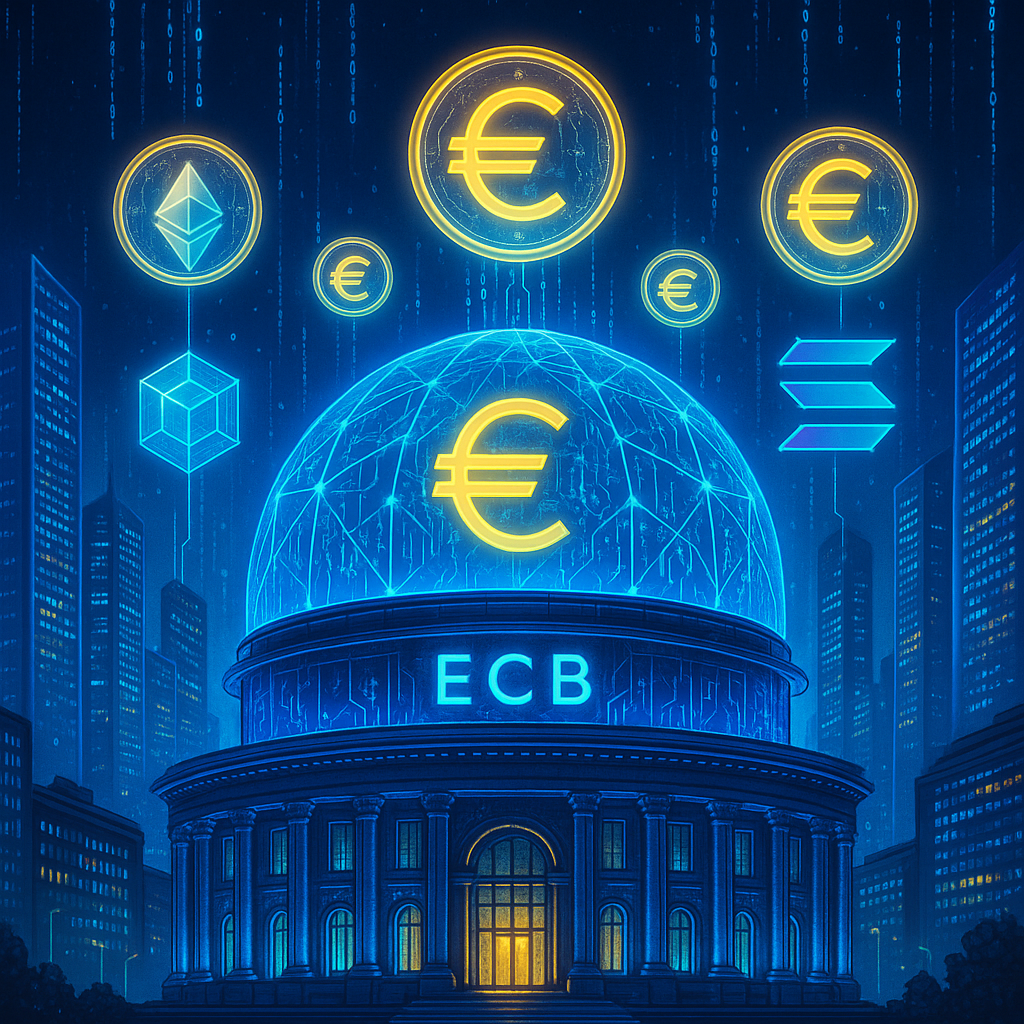EU Accelerates Digital Euro Plans After U.S. Stablecoin Law

EU accelerates digital euro plans after U.S. stablecoin law, with ECB exploring Ethereum and Solana to strengthen Europe financial independence.
Table of Contents
- Introduction
- The GENIUS Act: A U.S. Catalyst for Stablecoin Regulation
- Why the EU is Fast-Tracking the Digital Euro
- ECB and Public Blockchains: Ethereum, Solana, and Beyond
- Strategic Implications for Europe’s Financial Independence
- Market Reactions and Industry Perspectives
- Future Outlook: The Race for Global Digital Currency Leadership
- Conclusion
Online advertising service 1lx.online
Introduction
The global financial landscape is undergoing one of its most transformative moments in history. With the recent passage of the GENIUS Act in the United States, which provides a clear regulatory framework for stablecoins, the European Union has accelerated its efforts to launch a digital euro.
Unlike previous initiatives that remained mostly theoretical, this time the European Central Bank (ECB) is actively considering deploying the digital euro on public blockchains like Ethereum and Solana. This signals not only a technological leap but also a geopolitical shift aimed at reducing dependence on U.S.-led financial infrastructure and reinforcing Europe’s financial sovereignty.
The GENIUS Act: A U.S. Catalyst for Stablecoin Regulation
The GENIUS Act (Global Exchange for Neutral and Independent Universal Stablecoins) represents the most comprehensive legal framework for stablecoins ever enacted in the U.S. Its goals include:
- Establishing a licensing regime for stablecoin issuers.
- Defining collateral standards and transparency requirements.
- Integrating stablecoins into mainstream banking while maintaining consumer protection.
“Stablecoins are to finance what the internet was to communication,” said U.S. Senator Lisa Grant during the Act’s introduction.
The U.S. move effectively legitimized USD-backed stablecoins like USDC and PayPal’s PYUSD, setting a new benchmark for how central banks and regulators worldwide must adapt.
Why the EU is Fast-Tracking the Digital Euro
Online advertising service 1lx.online
The EU has long debated the merits of a Central Bank Digital Currency (CBDC), but the GENIUS Act created a sense of urgency. Policymakers in Brussels now fear that if the eurozone lags behind, the U.S. dollar—strengthened by regulated stablecoins—will dominate the digital economy.
Key drivers for Europe’s acceleration include:
- Monetary sovereignty: Avoiding over-reliance on U.S. dollar stablecoins.
- Technological competitiveness: Ensuring European fintech innovation is not overshadowed.
- Financial inclusion: Offering citizens a safe, blockchain-based digital euro alternative.
ECB and Public Blockchains: Ethereum, Solana, and Beyond
In a groundbreaking development, insiders at the European Central Bank have revealed active consideration of deploying the digital euro on public blockchains such as:
Online advertising service 1lx.online
- Ethereum: Renowned for its robust DeFi ecosystem and institutional adoption.
- Solana: Known for high-speed, low-cost transactions.
- Hybrid models: Combining public ledger transparency with ECB’s oversight.
This approach would contrast sharply with China’s digital yuan, which remains confined to state-controlled infrastructure. A blockchain-native euro could integrate seamlessly with the Web3 ecosystem, from smart contracts to digital identity systems.

Strategic Implications for Europe’s Financial Independence
If successful, the digital euro could provide Europe with:
- Reduced reliance on SWIFT and U.S.-controlled payment systems.
- Enhanced geopolitical resilience amid shifting alliances.
- New financial infrastructure that enables instant cross-border settlements.
According to a report from the European Parliament, “The digital euro may be the linchpin that finally aligns European finance with the digital-first century.”

Market Reactions and Industry Perspectives
The crypto and fintech sectors have responded enthusiastically to the ECB’s signals:
- PayPal Europe has hinted at potential integration of PYUSD with the digital euro.
- JPMorgan’s Onyx division, already piloting blockchain settlement layers, sees opportunities for euro liquidity pools.
- Ethereum Foundation experts noted that “a digital euro on Ethereum could instantly plug into the largest decentralized finance ecosystem in the world.”
However, some critics warn of risks, including:
- Privacy concerns if the ECB directly tracks retail transactions.
- Potential instability from relying on still-evolving public blockchain networks.
- Competition with commercial banks’ digital services.

Future Outlook: The Race for Global Digital Currency Leadership
The digital euro project now stands at a critical juncture. With pilot programs expected to launch by 2026, Europe could either:
- Leap ahead by embracing blockchain-native infrastructure.
- Or fall behind if political fragmentation slows decision-making.
Globally, the digital currency race is intensifying:
- The U.S. is setting standards with the GENIUS Act.
- China already leads with its digital yuan rollout.
- Emerging markets are exploring stablecoin-pegged solutions to bypass dollar dependency.
The question remains: will the euro become the third pillar of digital money or a latecomer struggling for relevance?
Conclusion
The passage of the GENIUS Act in the U.S. has lit a fire under Europe’s CBDC ambitions. The digital euro, once a cautious idea, is now a pressing geopolitical project. By considering public blockchains like Ethereum and Solana, the ECB signals that Europe does not want to simply copy others—it wants to innovate.
Whether Europe succeeds will depend on its ability to balance regulation, privacy, and innovation. But one thing is certain: the future of money is no longer theoretical—it’s being built in real time.
Our creator. creates amazing NFT collections!
Support the editors - Bitcoin_Man (ETH) / Bitcoin_Man (TON)
Pi Network (Guide)is a new digital currency developed by Stanford PhDs with over 55 million participants worldwide. To get your Pi, follow this link https://minepi.com/Tsybko and use my username (Tsybko) as the invite code.
Binance: Use this link to sign up and get $100 free and 10% off your first months Binance Futures fees (Terms and Conditions).
Bitget: Use this link Use the Rewards Center and win up to 5027 USDT!(Review)
Bybit: Use this link (all possible discounts on commissions and bonuses up to $30,030 included) If you register through the application, then at the time of registration simply enter in the reference: WB8XZ4 - (manual)
